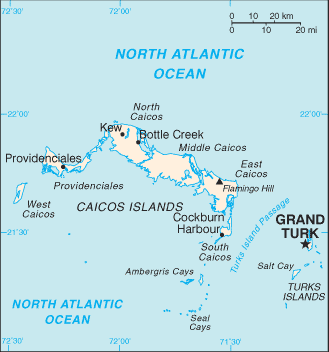|
Turks and Caicos Islands
|

|
Capital: Grand Turk (Cockburn Town)
Population: 38,191
Brief History of Turks and Caicos Islands:
The Turks and Caicos are island territories of Britain located in the Caribbean Sea. They were first inhabited by the Native American Taino.
The first European to discover the islands was explorer Juan Ponce de Leon from Spain in 1512. The Spanish began to capture the local natives to use as slaves on Hispaniola. Soon the islands were uninhabited.
Being uninhabited, the islands became a hideout for pirates. It wasn't until the 18th century that people began to settle on the island. In 1799 the islands became pare of the British colonies. Today they are still a British territory.
The Geography of Turks and Caicos Islands
Total Size: 430 square km
Size Comparison: 2.5 times the size of Washington, DC
Geographical Coordinates: 21 45 N, 71 35 W
World Region or Continent: Central America
General Terrain: low, flat limestone; extensive marshes and mangrove swamps
Geographical Low Point: Caribbean Sea 0 m
Geographical High Point: Blue Hills 49 m
Climate: tropical; marine; moderated by trade winds; sunny and relatively dry
Major cities: GRAND TURK (capital) 6,000 (2009)
The People of Turks and Caicos Islands
Type of Government: NA
Languages Spoken: English (official)
Independence: none (overseas territory of the UK)
National Holiday: Constitution Day, 30 August (1976)
Nationality: none
Religions: Baptist 40%, Anglican 18%, Methodist 16%, Church of God 12%, other 14% (1990)
National Symbol:
National Anthem or Song: This Land of Ours
Economy of Turks and Caicos Islands
Major Industries: tourism, offshore financial services
Agricultural Products: corn, beans, cassava (tapioca), citrus fruits; fish
Natural Resources: spiny lobster, conch
Major Exports: lobster, dried and fresh conch, conch shells
Major Imports: food and beverages, tobacco, clothing, manufactures, construction materials
Currency: US dollar (USD)
National GDP: $216,000,000
** Source for population (2012 est.) and GDP (2011 est.) is CIA World Factbook.
Back to Geography Home Page
